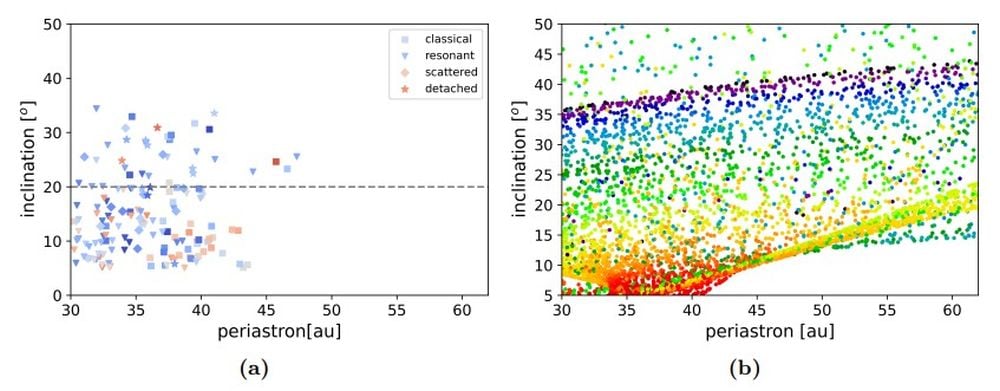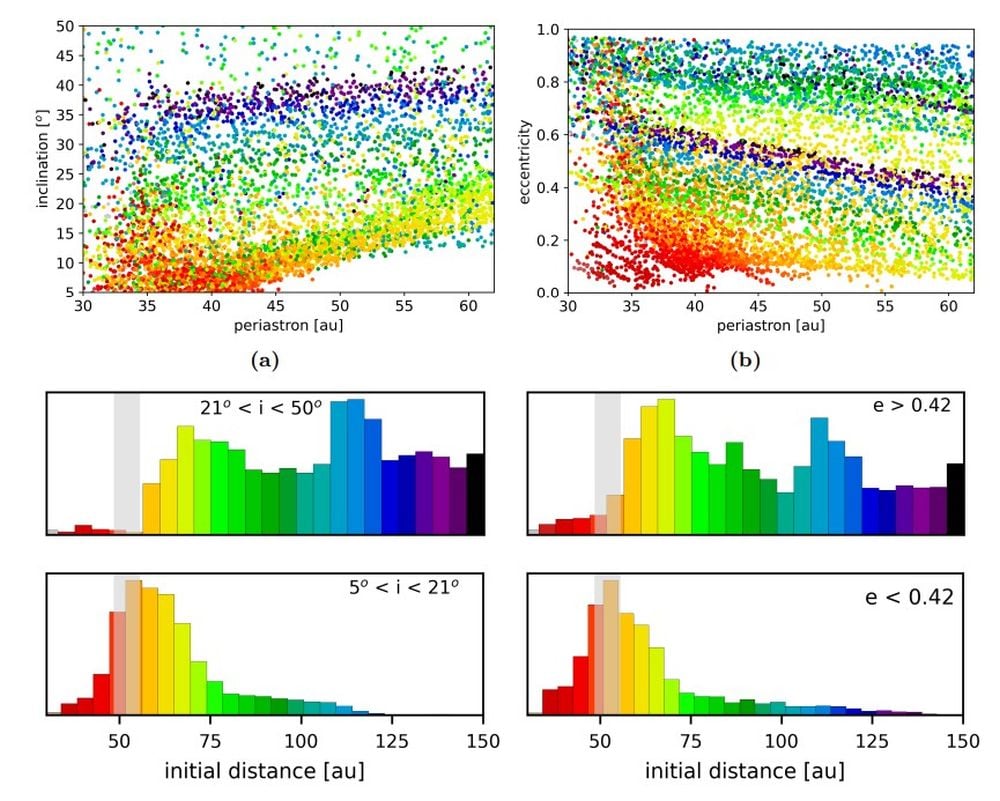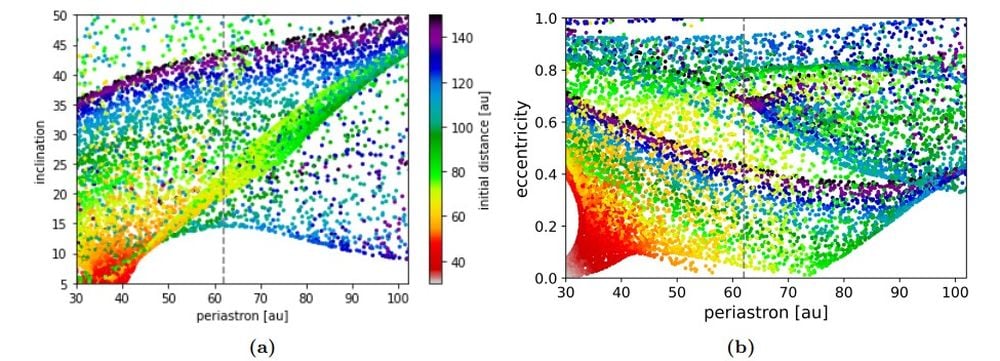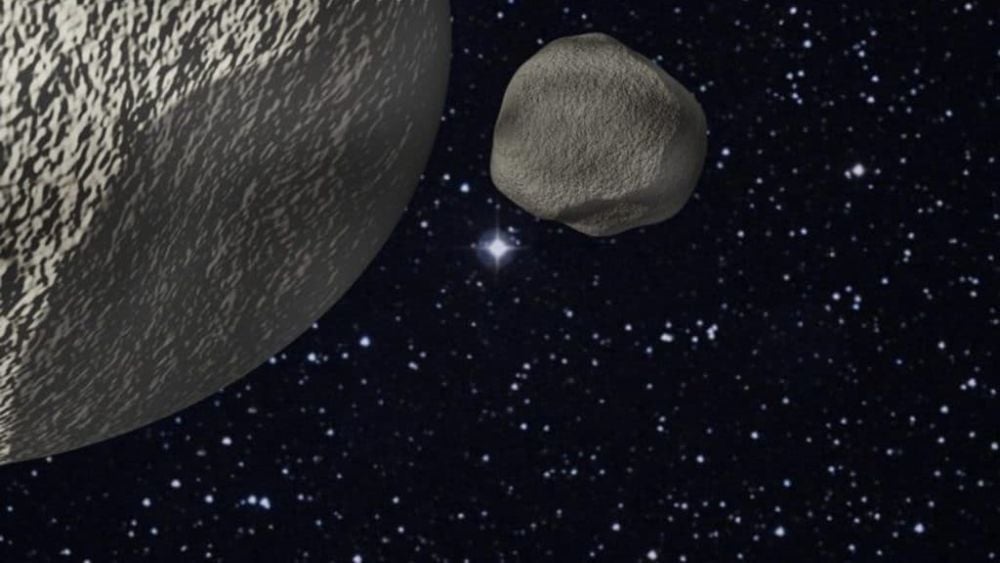Trans-Neptunian Objects (TNO) are some of our Solar System’s lesser-known objects. They number in the thousands, and they get their name from their orbits. These dwarf planets that orbit the Sun at a greater average distance than Neptune does. Pluto is the group’s most well-known member, having been demoted from planet to TNO in recent years.
TNOs are relics from the early Solar System. They formed in the cold, distant reaches of the protoplanetary disk. Back then, the young Solar System was more chaotic and dynamic, and as the giant planets migrated, gravitational interactions shaped the orbits that TNOs follow.
As a result, many follow eccentric orbits that are somewhat inclined to the planetary plane. They make up what is called the scattered disk. TNOs also have one other unusual feature: a complex color distribution from grey to red as revealed by surveys like the Outer Solar System Origins Survey (OSSOS) and the Dark Energy Survey. Astronomers think that’s due to the different ices and complex chemicals on their surfaces. Tholins are one of these chemicals, and they’re noteworthy for giving Pluto its reddish hue. (Though Pluto is a TNO, it is not part of the scattered disk.)
It’s notable that the colour distribution isn’t random and suggests a correlation with their orbits. So a TNOs colour is indicative of where in the protoplanetary disk it formed and its subsequent dynamical interactions with other bodies.
New research to be published in The Astrophysical Journal Letters suggests that TNOs unusual orbits and colors are the result of a stellar flyby. It’s titled “TNO colours provide new evidence for a past close flyby of another star to the Solar System,” and the lead author is Prof. Dr. Susanne Pfalzner from the Julich Supercomputing Center in Germany.
“TNOs are remnants of the planets’ formation from a disc of gas and dust, so it is puzzling that they move mostly on eccentric orbits inclined to the planetary plane and show a complex red-to-grey colour distribution,” the paper states. “A close stellar flyby can account for the TNOs’ dynamics but it is unclear if this can also explain the correlation between their colours and orbital characteristics.”
If a flyby occurred, it was likely very early in the Solar System’s history. “The flyby probably took place during the early phases of the Solar System in the Sun’s birth cluster,” the authors write. “In such clusters, the stellar density is about 1,000 to a million times higher than the local stellar density, and therefore, close flybys are much more common.”
To find out if a flyby can explain these TNO features, the researchers turned to supercomputer simulations. They simulated a 0.8 solar mass star performing a flyby of a disk modelled with 10,000 and 50,000 particles. Astronomers don’t know how large the Solar System’s disk was, but observations of other disks range from about 100 au to 500 au. “We model the effect of a flyby up to a radius of 150 au,” the authors write. The simulated perturber star reached a periastron distance of 110 au and was inclined by 70 degrees.
The researchers also used a colour gradient in their simulations to clarify the results. “We assume a colour gradient in the pre-flyby disc and represent it by a rainbow colour spectrum between 30 au and 150 au.”
One of the things the simulation showed was that a stellar flyby shepherded the TNOs into a spiral arm shape. “The perturber significantly alters their orbits, creating visible spiral arms due to the induced sub- and super-Keplerian velocities,” the researchers explain.
(a) shows the pre-flyby colour gradient in the simulated disc depicted by a false colour scheme representing very red to blue-grey TNOs. (b) is a snapshot from the simulation 128 years after periastron. The perturbing star entered from the bottom right and has already departed. Disk matter is transported inwards and outwards along the spiral arms, with a fraction of the test particles injected into the planet region. Image Credit: Pfalzner et al. 2025. The Astrophysical Journal Letters
TNOs are divided into dynamic groups by their orbits and the researchers write that their flyby successfully reproduced these groups, apart from resonant populations that were generated later through interactions with Neptune.
When it comes to colours, the results were similar to previous research showing that colour and orbital inclination are correlated. The authors explain that “red test particles are mainly found at low inclinations and periastron distances, suggesting that they retain more of their original dynamics.” On the other hand, green to blue particles dominate higher orbital inclinations, where red and orange particles are rare. The red test particles correspond to the very red TNOs, and the other colours represent the shades of grey observed for TNOs.
 This figure shows scatter plots of the TNOs’ inclination as a function of periastron distance.(a) shows observational data from other research for TNO orbital inclinations by periastron distance. (b) shows the simulation results. Image Credit: Pfalzner et al. 2025. The Astrophysical Journal Letters.
This figure shows scatter plots of the TNOs’ inclination as a function of periastron distance.(a) shows observational data from other research for TNO orbital inclinations by periastron distance. (b) shows the simulation results. Image Credit: Pfalzner et al. 2025. The Astrophysical Journal Letters.
The researchers ran the simulation for one billion years, and the simulation showed that the perturber’s effects became negligible by 12,000 years after periastron.
“After 1 Gyr, the overall structure is similar, with very red objects remaining rare among high-inclination and high-eccentricity TNOs,” the researchers write. They also explain that the colour patterns grow less distinct. Eventually, some red particles are ejected from the Solar System and others are shifted to high inclinations. “The distinct differences in the colour distributions between low- and high-inclination, as well as low- and high-eccentricity TNOs, persist,” they explain.
 This figure shows the long-term evolution of TNO orbits one billion years after periastron. (a) shows the connection between TNO colours and inclinations. (b) shows eccentricities, while (c) and (d) show the corresponding colour distributions. Image Credit: Pfalzner et al. 2025. The Astrophysical Journal Letters
This figure shows the long-term evolution of TNO orbits one billion years after periastron. (a) shows the connection between TNO colours and inclinations. (b) shows eccentricities, while (c) and (d) show the corresponding colour distributions. Image Credit: Pfalzner et al. 2025. The Astrophysical Journal Letters
The effort to understand our Solar System’s Trans-Neptunian Objects and their history will get a boost when the Vera Rubin Observatory begins its ten-year Legacy Survey of Space and Time (LSST). It could increase the number of known TNOs by ten times. That data will lead to a deeper, fuller understanding of the TNO population.
One way to verify their simulation’s accuracy is to use it to predict what the LSST will find. “In anticipation of this, we try to predict the colours of these soon-detectable TNOs from a flyby perspective,” the authors write. They focus on distant TNOs in this case, since they’re more likely to be spotted by the LSST. They say that if they’re correct, distant TNOs will be predominantly light red to shades of grey, while there will be a notable lack of bright red objects.
 These panels show anticipated results from the LSST. (a) shows inclinations, while (b) shows eccentricities for TNOs with perihelion distances greater than 60 au. Image Credit: Pfalzner et al. 2025. The Astrophysical Journal Letters.
These panels show anticipated results from the LSST. (a) shows inclinations, while (b) shows eccentricities for TNOs with perihelion distances greater than 60 au. Image Credit: Pfalzner et al. 2025. The Astrophysical Journal Letters.
The different colours of TNOs indicate the presence of different chemicals. In some cases, these chemicals have been weathered and altered, but the colours still constitute a strong clue about their origins and allow astronomers to track their evolution. This research shows that a stellar flyby can explain how TNOs have been shepherded into their unusual orbits.
“Assuming an initial colour gradient in the Sun’s debris disc, we found that the flyby accounts for the observed colour correlations from the OSSOS and DES surveys,” the researchers explain. “This simultaneous explanation of the TNO dynamics and colours significantly strengthens the argument for a stellar flyby largely determining the structure of the Solar System beyond Neptune,” they conclude.
